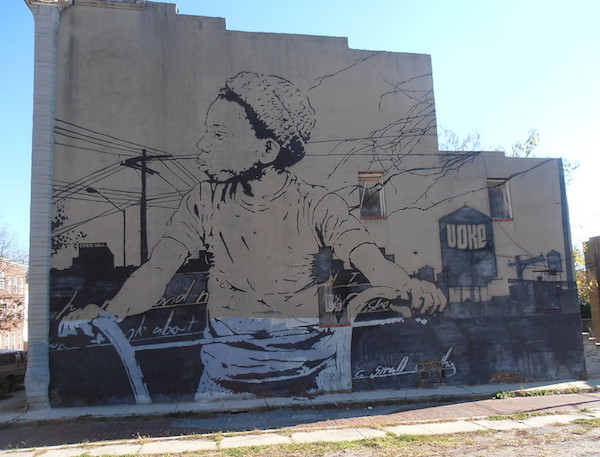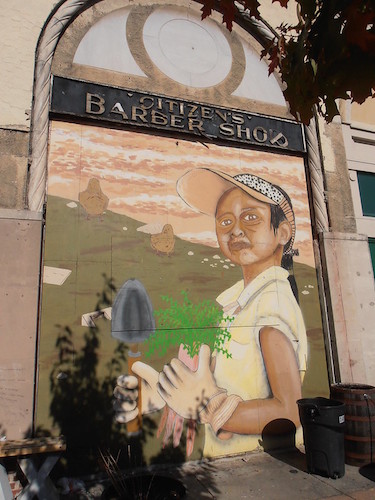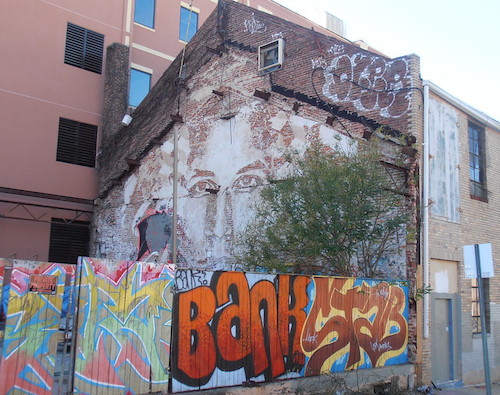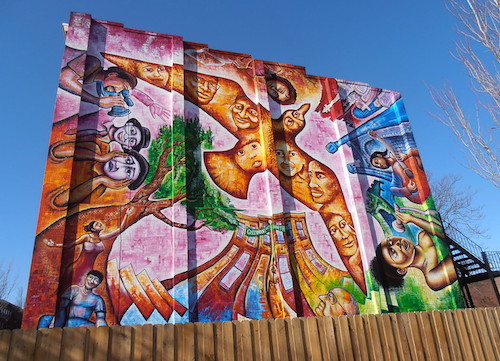As you enter the town of Berwyn Heights where we live, you pass a sign that says: “Welcome to Berwyn Heights: a Tree City USA”
“Tree City USA” is a designation from the Arbor Day Foundation meaning that Berwyn Heights spends a certain amount of money each year on urban forestry efforts, has an administrative board specifically tasked with overseeing those efforts, and has passed ordinances that generally make it difficult to have a tree cut down.
Kristen and I have joked for years that a more accurate designation would be “Welcome to Berwyn Heights: A VINE CITY USA, because there are vines running amok all over the neighborhood – up and down our street, anyway. Our backyard is covered in vines that have crept over the fence from our neighbors’ yards, and we can look over into their yards and see vines creeping over their fences from their neighbors’ yards.

I’ve been battling one vine in particular that I’ve nicknamed “the Sarlacc” (after the tentacled monster in Return of the Jedi). We’ve been trying to get rid of this plant for five years. The first year we lived in our house we thought the Sarlacc was great. It covered the trellis just off our back patio and provided a nice, shady barrier in the summertime. Then, the second year it covered the trellis…and the flowerbeds and the patio and the tree and was going after pretty much everything within its spindly reach. Since then, we’ve drowned it in Round Up, and come at it with clippers and loppers and chainsaws. Last year, I hacked the two main trunks of the vine up out of the ground with my pickaxe and stood over the fallen, severed stumps like a Celtic warrior, screaming in triumph. Even so, we still find tendrils of this vine popping up in various parts of the yard to this day.
Just last weekend, I noticed that something had sprung up and was pushing its way through the boards of the fence on the south end of our backyard. I thought it was a sapling of some kind that had taken root and shot up over night, but when I went to take a closer look IT WAS THE SARLACC. I then spent the next half hour trying to unravel it from the fence posts and wrench it from the ground.
Needless to say, I’ve about had it with vines. So when I hear Jesus declare, “I am the vine, you are the branches” in John 15, I’m not too thrilled with the metaphor. I much prefer the comparison Christ offered in our Scripture reading for last week: I am the Good Shepherd. Why don’t we just stick with that? Isn’t that enough? Why would Jesus want us to think of Him and think of ourselves as something so pervasive and invasive, that covers everything within reach, that scales walls and pushes holes through fences, and is next to impossible to get rid of?
So I asked Him. In a terse prayer, I asked Jesus what the deal with the vine was. And you know what? Within the depths of my soul, I heard a small but clear voice answer:

“Because we live in a world divided by too many walls and too many fences that need to be covered over and punched through. If you’re going to be My disciple, that’s the kind of tenacious presence I am calling you to have, the kind of love I’m calling you to spread. I’m not calling you to be any ol’ vine; I’m calling you to be a particular kind of vine, My vine, a vine that bears fruit; a vine that provides shade and sustenance for the people of my world. Love and sustenance – these are the necessities of “the life that truly is life” – and that is what my world desperately needs.

“If you need proof, just look north. The inner city of Baltimore burned last week for the same reason the California countryside burned last summer: it’s dry. It’s more than a food desert. It’s a desert of humanity, and it’s an environment that’s completely man-made. The high fences and thick walls of that city keep out the things that nourish life, and so all it takes is a spark. If it seems like history is repeating itself, that it’s 1968 all over again, it’s because these are the same fences and walls that stood 45 years ago. They’re still there. They’re still standing tall, because instead of pulling them down, America decided it would be better to install some gates. Gates are a step in the right direction; but a gate is the same as a wall if you don’t have a key.
“It’s time for the walls to come down. It’s time for the fences to come down. That’s why I’m in the world,” the small, clear voice declared. “That’s why I’m in the world as a vine: to crack the mortar and pry apart the boards that suffocate life. And that’s why I’m calling you, My people, to be branches of this vine: to spread out into the world, to be leverage for this work, to bear fruit, to offer love.”
“That’s why I’m in the world as a vine: to crack the mortar and pry apart the boards that suffocate life. And that’s why I’m calling you, My people, to be branches of this vine: to spread out into the world, to be leverage for this work, to bear fruit, to offer love.”
Was this the voice of the LORD? You can wonder with me. I do know these words within my soul are consistent with 1 John 4, the companion reading to John 15 in the Revised Common Lectionary. …[B]ecause love is from God; everyone who loves is born of God and knows God [and] whoever does not love does not know God, for God is love…. Beloved, since God loved us so much, we also ought to love one another. ….There is no fear in love, but perfect love casts out fear…. [Therefore] the commandment we have from Christ is this: those who love God must love their brothers and sisters also.

Love. That’s the fruit Christ calls us to bear. That’s the leverage He calls us to exert. And let’s be clear: the implications of the Gospel imperative to love are nothing short of cosmic. Because God loves us with deep and abiding love, we have the capacity to love one another with a deep and abiding love – and deep, abiding, divinely inspired love has the power to transform as well as save the world. The two actually go hand-in-hand. Where there is love, there should also be transformation, because love by its very nature is transformative. If you are loved, you are changed. If you love, you are changed. So, if our love isn’t transforming the world, then we have to wonder whether it’s love we’re truly offering. And if we aren’t transforming the world, can we really believe we’re saving it – even if a steady stream of folks “walk the aisle” on Sunday morning?
“Where there is love, there should also be transformation, because love by its very nature is transformative. If you are loved, you are changed. If you love, you are changed. So, if our love isn’t transforming the world, then we have to wonder whether it’s love we’re truly offering. “
We have the power, and we have the commission from Christ our Lord to change the world. The question is: do we have the will? Put another way, “How ‘viney’ are we willing to be?” The answer to that question is a mosaic of answers to other questions. Some of them are big questions: questions of public policy, and national and community priorities. Are we willing to engage those debates? Are we willing to demand better for our brothers, our sisters, our neighbors, even our enemies – all of the people Christ bids us to love? Others are small questions, in terms of scale if not ease. Will I choose to live out of generosity or fear? Will I go about my day with my eyes open or shut? Will I allow love to spur me to action, or will I hold back and wait for someone else to take the risk first?

Those are the kinds of questions love asks, and the answers to those kinds of questions will transform the world….or won’t.
And so, brothers and sisters, whatever you’ll be doing after you read this, resolve to do it with the love of Christ. Whether it’s difficult or easy, simple or complex, resolve to do it with the love of Christ. For He is the vine, and we are the branches. As He is in the world, so we are called to be in the world. We shouldn’t wait for the world to come to us, anymore than a vine waits for the trellis to come to it. There is mortar to be cracked, there are boards to be bent. There is life to let in.
May abundant life pour in like waters, and swell like a mighty stream through the cracks we make. Amen.
Featured Image courtesy of Alice Crumpton.























